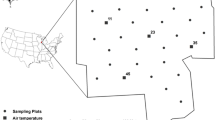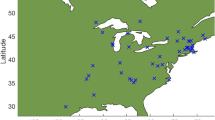Abstract
The spring indices, models that represent the onset of spring season biological activity, were developed using a long-term observational record from the mid-to-late twentieth century of three species of lilacs and honeysuckles contributed by volunteer observers across the nation. The USA National Phenology Network (USA-NPN) produces and freely delivers maps of spring index onset dates at fine spatial scale for the USA. These maps are used widely in natural resource planning and management applications. The extent to which the models represent activity in a broad suite of plant species is not well documented. In this study, we used a rich record of observational plant phenology data (37,819 onset records) collected in recent years (1981–2017) to evaluate how well gridded maps of the spring index models predict leaf and flowering onset dates in (a) 19 species of ecologically important, broadly distributed deciduous trees and shrubs, and (b) the lilac and honeysuckle species used to construct the models. The extent to which the spring indices predicted vegetative and reproductive phenology varied by species and with latitude, with stronger relationships revealed for shrubs than trees and with the Bloom Index compared to the Leaf Index, and reduced concordance between the indices at higher latitudes. These results allow us to use the indices as indicators of when to expect activity across widely distributed species and can serve as a yardstick to assess how future changes in the timing of spring will impact a broad array of trees and shrubs across the USA.



Similar content being viewed by others
References
Ault TR, Henebry GM, De Beurs KM, Schwartz MD, Betancourt JL, Moore D (2013) The false spring of 2012, earliest in North American record. EOS Trans Am Geophys Union 94:181–182
Ault TR, Schwartz MD, Zurita-Milla R, Weltzin JF, Betancourt JL (2015) Trends and natural variability of north American spring onset as evaluated by a new gridded dataset of spring indices. J Clim 28:8363–8378
Baker DJ, Hartley AJ, Butchart SH, Willis SG (2016) Choice of baseline climate data impacts projected species' responses to climate change. Glob Change Biol 22:2392–2404. https://doi.org/10.1111/gcb.13273
Balch JK, Schoennagel T, Williams AP, Abatzoglou JT, Cattau ME, Mietkiewicz NP, St. Denis LA (2018) Switching on the Big Burn of 2017. Fire 1:17
Basler D (2016) Evaluating phenological models for the prediction of leaf-out dates in six temperate tree species across central Europe. Agr Forest Meteorol 217:10–21
Beier CM, Signell SA, Luttman A, DeGaetano AT (2012) High-resolution climate change mapping with gridded historical climate products. Landsc Ecol 27:327–342
Biederman LA, Beckman J, Prekker J, Anderson D, Sather NP, Dahle R (2014) Phenological Monitoring Aids Habitat Management of Threatened Plant 34:105–110. https://doi.org/10.3375/043.034.0112
Bishop DA, Beier CM (2013) Assessing uncertainty in high-resolution spatial climate data across the US northeast. PLoS One 8:e70260
Cook B, Wolkovich E, Davies T, Ault TR, Betancourt JL, Allen JM, Bolmgren K, Cleland EE, Crimmins TM, Kraft NJB, Lancaster LT, Mazer SJ, McCabe GJ, McGill BJ, Parmesan C, Pau S, Regetz J, Salamin N, Schwartz MD, Travers SE (2012) Sensitivity of spring phenology to warming across temporal and spatial climate gradients in two independent databases. Ecosystems 15:1283–1294
Crimmins TM, Marsh RL, Switzer JR, Crimmins MA, Gerst KL, Rosemartin AH, Weltzin JF (2017) USA National Phenology Network gridded products documentation: U.S. Geological Survey Open-File Report 2017–1003. https://doi.org/10.3133/ofr20171003
Daly C (2006) Guidelines for assessing the suitability of spatial climate data sets. Int J Climatol 26:707–721. https://doi.org/10.1002/joc.1322
Daly C, Halbleib M, Smith JI, Gibson WP, Doggett MK, Taylor GH, Curtis J, Pasteris PP (2008) Physiographically sensitive mapping of climatological temperature and precipitation across the conterminous United States. Int J Climatol 28:2031–2064. https://doi.org/10.1002/joc.1688
Denny E, Gerst KL, Miller-Rushing A, Tierney G, Crimmins TM, Enquist CAF, Guertin P, Rosemartin A, Schwartz MD, Thomas K, Weltzin JF (2014) Standardized phenology monitoring methods to track plant and animal activity for science and resource management applications. Int J Biometeorol 58:591–601
Enquist CAF, Kellermann JL, Gerst KL, Miller-Rushing AJ (2014) Phenology research for natural resource management in the United States. Int J Biometeorol 58:579–589
U.S. Environmental Protection Agency (2016) Climate change indicators in the United States, 2016. Fourth edition. EPA 430-R-16-004. http://www.epa.gov/climate-indicators
Fernández M, Hamilton H, Kueppers LM (2013) Characterizing uncertainty in species distribution models derived from interpolated weather station data. Ecosphere 4:61. https://doi.org/10.1890/ES13-00049.1
Fuccillo KK, Crimmins TM, de Rivera CE, Elder TS (2015) Assessing accuracy in citizen science-based plant phenology monitoring. Int J Biometeorol 59:917–926. https://doi.org/10.1007/s00484-014-0892-7
Gerst KL, Kellermann JL, Enquist CAF, Rosemartin AH, Denny EG (2016) Estimating the onset of spring from a complex phenology database: trade-offs across geographic scales. Int J Biometeorol 60:391–400
Hayhoe K, Wake CP, Huntington TG et al (2007) Past and future changes in climate and hydrological indicators in the US northeast. Clim Dyn 28:381. https://doi.org/10.1007/s00382-006-0187-8
Heberling JM, Cassidy ST, Fridley JD, Kalisz S (2019) Carbon gain phenologies of spring-flowering perennials in a deciduous forest indicate a novel niche for a widespread invader. New Phytol 221:778–788. https://doi.org/10.1111/nph.15404
Hu Q, Weiss A, Feng S, Baenziger PS (2005) Earlier winter wheat heading dates and warmer spring in the US Great Plains. Agric For Meteorol 135:284–290. https://doi.org/10.1016/j.agrformet.2006.01.001
Izquierdo-Verdiguier E, Zurita-Milla R, Ault TR, Schwartz MD (2018) Development and analysis of spring plant phenology products: 36 years of 1-km grids over the conterminous US. Agric For Meteorol 262:34–41
Labe Z, Ault T, Zurita-Milla R (2016) Identifying anomalously early spring onsets in the CESM large ensemble project. Clim Dyn:1–18
Leimu R, Fischer M (2008) A meta-analysis of local adaptation in plants. PLoS One 3(12):e4010. https://doi.org/10.1371/journal.pone.0004010
Liang L (2016) Beyond the bioclimatic law: geographic adaptation patterns of temperate plant phenology. Progress Phys Geogr Earth Environ 40:811–834. https://doi.org/10.1177/0309133316656558
Liang L (2019) A spatially explicit modeling analysis of adaptive variation in temperate tree phenology. Agric For Meteorol 266:73–86
Liang L, Schwartz MD (2014) Testing a growth efficiency hypothesis with continental-scale phenological variations of common and cloned plants. Int J Biometeorol 58:1789–1797
Linkosalo T, Lappalainen HK, Hari P (2008) A comparison of phenological models of leaf bud burst and flowering of boreal trees using independent observations. Tree Physiol 28:1873–1882
Melaas EK, Friedl MA, Richardson AD (2016) Multi-scale modeling of spring phenology across deciduous forests in the eastern United States. Glob Chang Biol 22:792–805
Monahan WB, Rosemartin A, Gerst KL, Fisichelli NA, Ault T, Schwartz MD, Gross JE, Weltzin JF (2016) Climate change is advancing spring onset across the U.S. national park system. EcoSphere 7:e01465
Parmesan C (2007) Influences of species, latitudes and methodologies on estimates of phenological response to global warming. Glob Chang Biol 13:1860–1872
Peterson AG, Abatzoglou JT (2014) Observed changes in false springs over the contiguous United States. Geophys Res Lett 41:2156–2162
Pielke R, Marland G, Betts R, Chase T, Eastman JL, Niles J, Niyogi D, Running SW (2002) The influence of land-use change and landscape dynamics on the climate system: relevance to climate-change policy beyond the radiative effect of greenhouse gases. Philos Trans A Math Phys Eng Sci 360:1705–1719
Polgar C, Gallinat A, Primack RB (2014) Drivers of leaf out phenology and their implications for species invasions: insights from Thoreau’s concord. New Phytol 202:106–115
PRISM Climate group, Oregon State University (2019) http://prism.oregonstate.edu. Accessed Oct 2018
QGIS Development Team (2018) QGIS geographic information system. Open Source Geospatial Foundation Project. http://qgis.osgeo.org
Renner SS, Zohner CM (2018) Climate change and phenological mismatch in trophic interactions among plants, insects, and vertebrates. Annu Rev Ecol Evol Syst 49:165–182
Rosemartin A, Denny EG, Gerst KL, Marsh RL, Posthumus EE, Crimmins TM, Weltzin JF (2018) USA National Phenology Network observational data documentation: U.S. Geological Survey Open-File Report 24:2018–1060. https://doi.org/10.3133/ofr20181060
Rosemartin A, Denny E, Weltzin JF, Marsh RL, Wilson B, Mehdipoor H, Zurita-Milla R, Schwartz MD (2015) Lilac and honeysuckle phenology data 1956-2014. Sci Data 2:150038
Sakurai R, Jacobson SK, Kobori H, Primack R, Oka K, Komatsu N, Machida R (2011) Culture and climate change: Japanese cherry blossom festivals and stakeholders’ knowledge and attitudes about global climate change. Biol Conserv 144:654–658
Savolainen O, Pyhäjärvi T, Knürr T (2007) Gene flow and local adaptation in trees. Annu Rev Ecol Evol Syst 38:595–619
Schaber J, Badeck FW (2003) Physiology-based phenology models for forest tree species in Germany. Int J Biometeorol 47:193–201. https://doi.org/10.1007/s00484-003-0171-5
Schwartz MD (1997) Spring index models: an approach to connecting satellite and surface phenology. In: Lieth H, Schwartz MD (eds) Phenology of seasonal climates. Backhuys, Weesp, pp 23–38
Schwartz MD, Ahas R, Aasa A (2006) Onset of spring starting earlier across the northern hemisphere. Glob Chang Biol 12:343–351
Schwartz MD, Ault TR, Betancourt JL (2013) Spring onset variations and trends in the continental United States: past and regional assessment using temperature-based indices. Int J Climatol 33:2917–2922
Stine AR, Huybers P (2012) Changes in the seasonal cycle of temperature and atmospheric circulation. J Clim 25:7362–7380. https://doi.org/10.1175/JCLI-D-11-00470.1
USA-NPN (2019a) Data type: Individual Phenometrics. 2009-2018. USA-NPN, Tucson, Arizona, USA.https://doi.org/10.5066/F78S4N1V
USA National Phenology Network (2019b) Spring indices, historical annual first leaf - first bloom - USA-NPN, Tucson, Arizona, USA. https://doi.org/10.5066/F7XD0ZRK
USGCRP (2018) In: Reidmiller DR, Avery CW, Easterling DR, Kunkel KE, Lewis KLM, Maycock TK, Stewart BC (eds) Impacts, risks, and adaptation in the United States: Fourth National Climate Assessment, vol II. U.S. Global Change Research Program, Washington, 1515. https://doi.org/10.7930/NCA4.2018
Visser ME, Both C (2005) Shifts in phenology due to global climate change: the need for a yardstick. Proc Biol Sci 272:2561–2569. https://doi.org/10.1098/rspb.2005.3356
Wallace C, Walker J, Skirvin S, Patrick-Birdwell C, Weltzin J, Raichle H (2016) Mapping presence and predicting phenological status of invasive buffelgrass in southern Arizona using modis, climate and citizen science observation data. Remote Sens 8:524
Waller EK, Crimmins TM, Walker JJ, Posthumus EE, Weltzin JF (2018) Differential changes in the onset of spring across US National Wildlife Refuges and North American migratory bird flyways. PLoS One 13(9):e0202495. https://doi.org/10.1371/journal.pone.0202495
Wang R, Gamon J, Montgomery R, Townsend P, Zygielbaum A, Bitan K, Tilman D, Cavender-Bares J (2016) Seasonal variation in the NDVI–species richness relationship in a prairie grassland experiment (Cedar Creek). Remote Sens 8:128
Wolfe DW, Schwartz MD, Lakso AN, Otsuki Y, Pool RM, Shaulis NJ (2005) Climate change and shifts in spring phenology of three horticultural woody perennials in northeastern USA. Int J Biometeorol 49:303–309. https://doi.org/10.1007/s00484-004-0248-9
Acknowledgments
The authors are grateful to USA-NPN National Coordinating Office staff for providing feedback on this work and contributing to the infrastructure to collect, manage, and communicate these results, particularly Ellen Denny, Lee Marsh, Jeff Switzer, and Jake Weltzin. The authors appreciate the comments of two anonymous reviewers whose insights greatly improved the manuscript. Data were provided by the USA National Phenology Network and the many participants who contribute to its Nature’s Notebook program. Lilac and honeysuckle data were provided by the USA National Phenology Network, Joseph M. Caprio, and all contributors to past U.S. Dept. of Agriculture regional phenology projects. The project was supported by Cooperative Agreement Number G14AC00405 and G18AC00135 from the U.S. Geological Survey and by NASA grant NAA112AC79B.
Author information
Authors and Affiliations
Corresponding author
Rights and permissions
About this article
Cite this article
Gerst, K.L., Crimmins, T.M., Posthumus, E.E. et al. How well do the spring indices predict phenological activity across plant species?. Int J Biometeorol 64, 889–901 (2020). https://doi.org/10.1007/s00484-020-01879-z
Received:
Revised:
Accepted:
Published:
Issue Date:
DOI: https://doi.org/10.1007/s00484-020-01879-z




